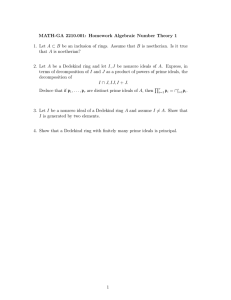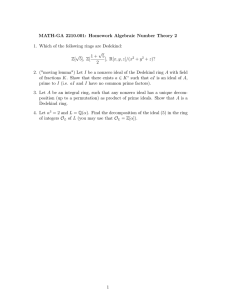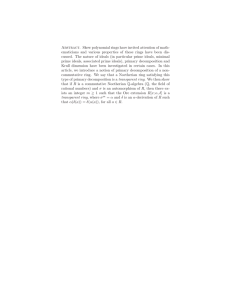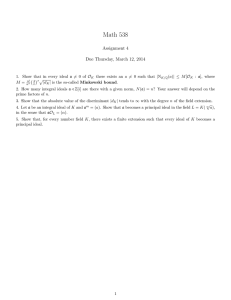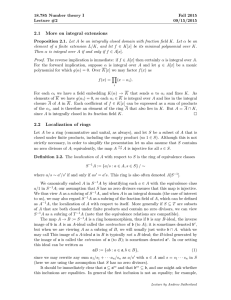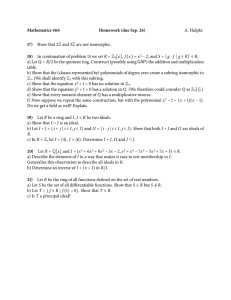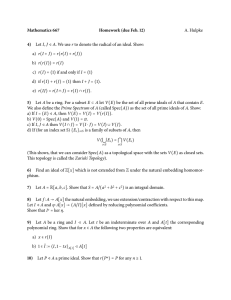2.1 More on integral extensions
advertisement
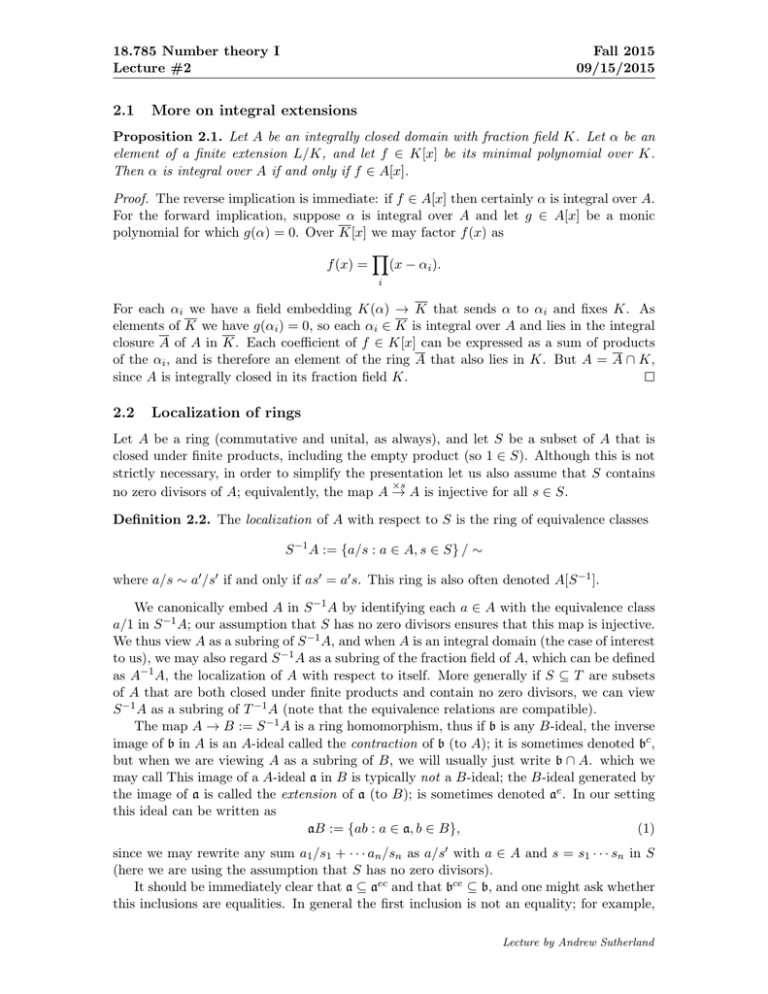
18.785 Number theory I
Lecture #2
2.1
Fall 2015
09/15/2015
More on integral extensions
Proposition 2.1. Let A be an integrally closed domain with fraction field K. Let α be an
element of a finite extension L/K, and let f ∈ K[x] be its minimal polynomial over K.
Then α is integral over A if and only if f ∈ A[x].
Proof. The reverse implication is immediate: if f ∈ A[x] then certainly α is integral over A.
For the forward implication, suppose α is integral over A and let g ∈ A[x] be a monic
polynomial for which g(α) = 0. Over K[x] we may factor f (x) as
Y
f (x) =
(x − αi ).
i
For each αi we have a field embedding K(α) → K that sends α to αi and fixes K. As
elements of K we have g(αi ) = 0, so each αi ∈ K is integral over A and lies in the integral
closure A of A in K. Each coefficient of f ∈ K[x] can be expressed as a sum of products
of the αi , and is therefore an element of the ring A that also lies in K. But A = A ∩ K,
since A is integrally closed in its fraction field K.
2.2
Localization of rings
Let A be a ring (commutative and unital, as always), and let S be a subset of A that is
closed under finite products, including the empty product (so 1 ∈ S). Although this is not
strictly necessary, in order to simplify the presentation let us also assume that S contains
×s
no zero divisors of A; equivalently, the map A → A is injective for all s ∈ S.
Definition 2.2. The localization of A with respect to S is the ring of equivalence classes
S −1 A := {a/s : a ∈ A, s ∈ S} / ∼
where a/s ∼ a0 /s0 if and only if as0 = a0 s. This ring is also often denoted A[S −1 ].
We canonically embed A in S −1 A by identifying each a ∈ A with the equivalence class
a/1 in S −1 A; our assumption that S has no zero divisors ensures that this map is injective.
We thus view A as a subring of S −1 A, and when A is an integral domain (the case of interest
to us), we may also regard S −1 A as a subring of the fraction field of A, which can be defined
as A−1 A, the localization of A with respect to itself. More generally if S ⊆ T are subsets
of A that are both closed under finite products and contain no zero divisors, we can view
S −1 A as a subring of T −1 A (note that the equivalence relations are compatible).
The map A → B := S −1 A is a ring homomorphism, thus if b is any B-ideal, the inverse
image of b in A is an A-ideal called the contraction of b (to A); it is sometimes denoted bc ,
but when we are viewing A as a subring of B, we will usually just write b ∩ A. which we
may call This image of a A-ideal a in B is typically not a B-ideal; the B-ideal generated by
the image of a is called the extension of a (to B); is sometimes denoted ae . In our setting
this ideal can be written as
aB := {ab : a ∈ a, b ∈ B},
(1)
since we may rewrite any sum a1 /s1 + · · · an /sn as a/s0 with a ∈ A and s = s1 · · · sn in S
(here we are using the assumption that S has no zero divisors).
It should be immediately clear that a ⊆ aec and that bce ⊆ b, and one might ask whether
this inclusions are equalities. In general the first inclusion is not an equality; for example,
Lecture by Andrew Sutherland
if a ∩ S 6= ∅ then ae , and therefore aec , is the unit ideal, which may be larger than a. But
the second inclusion is always an equality; see [1, Prop. 11.19] or [2, Prop. 3.11] for a short
proof. We also note the following theorem.
Theorem 2.3. The map q 7→ q ∩ A defines a bijection from the set of prime ideals of S −1 A
and the set of prime ideals of A that do not intersect S. The inverse map is p 7→ pS −1 A.
Proof. See [1, Cor. 11.20] or [2, Prop. 3.11.iv].
Remark 2.4. An immediate consequence of (1) is that if a1 , . . . , an ∈ A generate a as an
A-ideal, then they also generate ae as a B-ideal, and every B-ideal b is of this form (take
a = bc ). Thus if A is noetherian then so are all its localizations, and if A is a PID then so
are all of its localizations.
An important special case of localization occurs when p is a prime ideal in an integral
domain A and S = A − p (the complement of the set p in the set A). In this case it is
customary to denote S −1 A by
Ap := {a/b : a ∈ A, b 6∈ p}/ ∼
(2)
and call it the localization of A at p. The prime ideals of Ap are then in bijection with the
prime ideals of A that lie in p. It follows that pAp is the unique maximal ideal of A, thus
Ap is a local ring.
The ring Ap is an extension of A that lies its fraction field; we have the tower of rings
A ⊆ Ap ⊆ Frac A.
In the case p = (0), we have Ap = Frac A, but otherwise Ap is properly contained in Frac A.
Warning 2.5. The notation in (2) makes it tempting to assume that if a/b is an element
of Frac A, then a/b ∈ Ap if and only if b 6∈ p. This is not necessarily true! As an element of
Frac A, the notation “a/b” represents an equivalence class [a/b], and if [a/b] = [a0 /b0 ] with
b0 6∈ Ap , then in fact [a/b] ∈ Ap . As a trivial example, take A = Z, p = (3), a/b = 9/3 and
a0 /b0 = 3/1. You may object that we should write a/b in lowest terms, but when A is not
a unique factorization domain it is not necessarily clear what this means.
Example 2.6. For a field k, let A = k[x] and p = (x − 2). Then
Ap = {f ∈ k(x) : f is defined at 2}.
The ring A is a PID, so Ap is a local PID, hence a DVR, and its unique maximal ideal is
pAp = {f ∈ k(x) : f (2) = 0}.
The valuation on the field k(x) = Frac A corresponding to the valuation ring Ap measures
the order of vanishing of functions f ∈ k(x) at 2. The residue field is Ap /pAp ' k, and the
quotient map Ap Ap /pAp sends f (x) to f (2).
Example 2.7. Let p ∈ Z be a prime. Then Z(p) = {a/b : a, b ∈ Z, p - b}. As in the previous
example, Z is a PID, so Z(p) is a local PID, hence a DVR, and the corresponding valuation
on Q is the p-adic valuation.
18.785 Fall 2015, Lecture #2, Page 2
2.3
Localization of modules
The concept of localization generalizes to modules. As above, let A be a ring and let S a
×s
subset of A closed under finite products. If M is an A-module such that the map M → M
is injective for all s ∈ S (this is a strong assumption that imposes constraints on both S
and M , but it holds in the cases we care about), then the set
S −1 M := {m/s : m ∈ M, s ∈ S}/ ∼
is an S −1 A-module (the equivalence is m/s ∼ m0 /s0 ⇔ s0 m = sm0 , as usual). We could
equivalently define S −1 M := M ⊗A S −1 A (see [2, Prop. 3.5]). We will usually take S = A−p,
in which case we write Mp for S −1 M , just as we write Ap for S −1 A.
Proposition 2.8. Let A be a subring of a field K, and let M be an A-module contained in
a K-vector space V (equivalently, for which the map M → M ⊗A K is injective).1 Then
\
\
M=
Mm =
Mp ,
m
p
where m ranges over the maximal ideals of A and p ranges over the prime ideals of A and
the intersections takes place in V .
T
T
Proof. The fact that M ⊆ m Mm is immediate. Now suppose x ∈ m Mm . The set
{a ∈ A : ax ∈ M } is an A-ideal a, and it is not contained in any maximal ideal m, since
a ⊆ m implies x 6∈ Mm . Therefore a = (1), so x = 1 · x ∈ M .
We now note that each Mp contains some Mm (since each p is contained in some m),
and every maximal ideal is prime, so ∩m Mm = ∩p Mp .
Several important special cases of this proposition occur when A is a domain, K is
its fraction field, and M is an A-submodule of K. The ideals I of A are precisely its Asubmodules, each of which can be localized as above, and the result is just the extension of
the ideal to the corresponding localization of A. In particular, if p is a prime ideal then
Ip = IAp ,
and more generally, Mp = M Ap . We also have the following corollary of Proposition 2.8.
Corollary 2.9. Let A be a domain. Every ideal I of A (including I = A) is equal to the
intersection of its localizations at the maximal ideals of A (and also to the intersection of
its localizations at the prime ideals of A).
T
Example 2.10. If A = Z then Z = p Z(p) in Q.
2.4
Dedekind domains
Proposition 2.11. Let A be a noetherian domain. The following are equivalent:
(i) For every nonzero prime ideal p ⊂ A the local ring Ap is a DVR.
(ii) The ring A is integrally closed and dim A ≤ 1.
1
The image is a tensor product of A-modules that is also a K-vector space. We need the natural map to
be injective in order to embed M in it. Note that V necessarily contains a subspace isomorphic to M ⊗A K.
18.785 Fall 2015, Lecture #2, Page 3
Proof. If A is a field then (i) and (ii) both hold, so let us assume that A is not a field, and
put K := Frac A. We first show that (i) implies (ii). Recall that dim A is the supremum
of the length of all chains of prime ideals. It follows from Theorem 2.3 that every chain
of prime ideals (0) ( p1 ( · · · ( pn extends to a corresponding chain in Apn of the same
length, and conversely, every chain in Ap contracts to a chain in A of the same length, thus
dim A = sup{dim Ap : p ∈ Spec A} = 1
since every Ap is either a DVR (p 6= (0)), in which case dim Ap = 1, ora field (p = (0)), in
which case dim Ap = 0. Any a ∈ K that is integral over A isTintegral over every Ap (since
they all contain A), and the Ap are integrally closed. So a ∈ p Ap = A, and therefore A is
integrally closed, which shows (ii).
To show that (ii) implies (i), we first show that the following properties are all inherited
by localizations of a ring: (1) domain, (2) noetherian, (3) dimension at most one, (4)
integrally closed. (1) is obvious, (2) was noted in Remark 2.4, and (3) follows from the
fact that every chain of prime ideals in Ap extends to a chain of prime ideals in A of the
same length (as argued above), so dim Ap ≤ dim A always holds. To show (4), suppose that
x ∈ K = Frac Ap is integral over Ap . Then
an−1 n−1
a1
a0
xn +
=0
x
+ ··· + x +
s0
sn−1
s1
for some a0 , . . . , an−1 ∈ A and s0 , . . . , sn−1 ∈ A − p. Multiplying both sides by sn , where
s = s0 · · · sn−1 ∈ S, shows that sx is integral over A, hence an element of A, since A is
integrally closed. But then sx/s = x is an element of Ap , so Ap is integrally closed as
claimed.
Assuming (ii), every Ap is an integrally closed noetherian local domain of dimension
at most 1, and if p 6= (0), then dim Ap ≥ 1 (consider the chain (0) ⊆ pAp ) and therefore
dim Ap = 1. Thus for every nonzero prime ideal p, the localization Ap is an integrally closed
noetherian local domain of dimension 1, and therefore a DVR, by Theorem 1.14.
Definition 2.12. A noetherian domain satisfying either of the equivalent properties of
Proposition 2.11 is called a Dedekind domain.
Corollary 2.13. Every PID is a Dedekind domain. In particular, Z is a Dedekind domain,
as is k[x] for any field k.
Remark 2.14. Not every UFD is a Dedekind domain
√ (consider k[x, y], for any field k), and
not every Dedekind domain is a UFD (consider Z[ −5]).
√ We will see that ring of integers
of a number field K is √
a Dedekind domain; the ring Z[ −5] is not the ring of integers of
√
Q( −5), which is Z[ 1+ 2 −5 ].
More generally, we will prove that if A is a Dedekind domain and L is a finite separable
extension of its fraction field, then the integral closure of A in L is a Dedekind domain.
References
[1] Allen Altman and Steven Kleiman, A term of commutative algebra, Worldwide Center
of Mathematics, 2013.
[2] Michael Atiyah and Ian MacDonald, Introduction to commutative algebra, Addison–
Wesley, 1969.
18.785 Fall 2015, Lecture #2, Page 4
MIT OpenCourseWare
http://ocw.mit.edu
18.785 Number Theory I
Fall 2015
For information about citing these materials or our Terms of Use, visit: http://ocw.mit.edu/terms.
